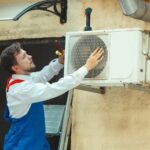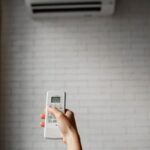How Do You Fix a Heat Pump That Blows Cold Air?
Heat pumps are used in a large number of homes as part of their HVAC systems. After all, when used correctly, they’re a sturdy, durable, and energy-efficient heating choice. Now that winter has arrived, the demand for heating solutions is at an all-time high. As a result, homeowners are requesting inspections, upkeep, and furnace repair in Sacramento to help prepare for the impending cold.
Heat pumps typically let out air that is between 85 and 92 degrees Fahrenheit. This is quite enough to bring your home to the comfortable temperature. However, the air that comes out of the vents can be cold for a variety of reasons:
- New heat pump users may find 85-92°F to be too cool.
- Your body temperature is roughly 98.6 degrees Fahrenheit.
How Can You Tell If There’s a Problem?
There are several ways that you can tell if your heat pump is actually blowing chilly air when it shouldn’t.
- Use an infrared thermometer to measure the temperature of the air flowing out of your vents to see if there is cold air.
- Keep an eye on your thermostat. The temperature in your home should gradually rise until it reaches the appropriate temperature. The heat pump should then turn off.
Everything is fine as long as that is the case. But what if the heater doesn’t work the way you need it to?
It is Possible That Your Heat Pump is in Defrost Mode
Some heat pumps are also function as reverse air conditioners. These systems generate heat by drawing in cold air, turning it to heat, and evenly distributing it around your home. When some heat pump types are in defrost mode, this allows them to reroute hot air.
When it’s tough to get to your outdoor unit to access or examine it, this HVAC feature comes in handy. The defrost mode aids in the melting of ice buildup on your outside unit, making it easier to access it. Switch your unit to heating mode if it’s in defrost mode because it won’t emit hot air until the defrost cycle is complete.
You Have Got a Frozen Heat Pump
Even during normal functioning, your heat pump can generate frost or ice on the exterior coils, which may look strange. This can also happen if your heat pump system is overworked. You’ll notice that ice begins to freeze, and your unit produces frigid air.
If ice builds up in the coils, your heat pump switches to the cooling mode for a short time to reverse the refrigerant flow. The hot refrigerant travels through the outer coils during cooling mode to dissolve the ice deposit and defrost the system.
If your heat pump begins to freeze, it’s not a problem you should attempt to resolve on your own. Due to the unit’s complexity, it should be left in the hands of a certified technician for furnace repair in Sacramento. After all, you don’t want to cause any more harm to your unit.
Also, you should not put off scheduling HVAC repairs as failing to do so could result in irreversible damage to your equipment. Furthermore, if your heating system isn’t working then the temperature in your home may become uncomfortable.
Here are a few possible causes for a frozen heat pump:
- Refrigerant levels are low
- Defrost controls aren’t working properly
- Defrost thermostats or sensors aren’t working properly
- Defrost relay isn’t working properly
- The reversing valve is stuck
- Outdoor fan motors are damaged
If your heat pump is covered in frost or ice, turn it off, and contact your local HVAC specialist for assistance. While you’re waiting for them, try the following troubleshooting tips:
- Make sure the air filter in your HVAC system isn’t blocked or broken
- Examine your indoor air vents and registers to verify nothing is obscuring the unit
- Remove any leaves, grass, snow, mud, or other materials
- Make sure your gutters aren’t overflowing
Some Things to Remember
The distinctions between a heat pump and a furnace may be on some homeowners’ minds. The fact that furnaces send out scorching hot air is what distinguishes them. This means that approaching the furnace itself would be unsafe because it is extremely hot. Heat pumps, on the other hand, produce warm air that is between 85 and 90 degrees Fahrenheit.
Check your thermostat every 30 minutes after turning on your heat pump to see how hot the air is. It should predict that the inside temperature will reach 85 to 90 degrees in about an hour.
If your heat pump continues to malfunction after you’ve performed the basic troubleshooting methods outlined in the user guide, you’ll need to contact a local HVAC specialist to have it evaluated. Keep in mind that some components may need to be changed, so you’ll need to plan ahead for a period of reduced heating.
Once everything is in order, make sure to have your HVAC unit tested and maintained on a regular basis in order to get the most out of it. For personalized furnace repair in Sacramento, feel free to contact us at (916) 246-2089.




